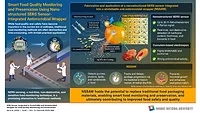Researchers Develop Antimicrobial 'Jelly Ice Cubes' for Safer Cold Storage

Credit Gregory Urquiaga/UC Davis
Researchers at the University of California Davis (UC Davis) have developed a new type of cooling cube that could improve cold storage and the shipment of fresh food without relying on ice or traditional cooling packs, which can carry microbiological and cross-contamination hazards.
The plastic-free "jelly ice cubes" do not melt, are antimicrobial and mold-resistant, are compostable and reusable, and prevent cross-contamination. The cubes comprise more than 90% water and other components to stabilize the structure and are soft to the touch. They change color based on temperature and can be molded into any shape. A patent for the cooling cubes was filed in July.
The idea for the jelly cooling cubes was borne from an observation by one of the researchers, Luxin Wang, an Associate Professor in UC Davis' Department of Food Science and Technology. Dr. Wang observed that fish processing plants use an enormous amount of ice, and that the meltwater from that ice could cross-contaminate other products or water supplies. The project researchers also noted that mold is often found in plastic ice packs used in shipping packages and in school lunches for children.
"The amount of ice used by these fish processing sites is massive. We need to control the pathogens," Wang said.
The cooling cubes can withstand 22 pounds of pressure without losing form, and can be reused around a dozen times after a quick rinse with water or diluted bleach. After the cubes have reached end of life, they can be disposed of in the trash or with yard waste. The researchers hope to eventually use recycled agricultural waste or byproduct as the coolant material to make the cubes as sustainable as possible.
As an alternative to ice, the new cooling cubes are hoped to help reduce water use in the food supply chain, thereby reducing environmental impact, food waste, and microbial contamination. They also offer stable temperatures to reduce food spoilage and could be used by food producers, shipping businesses, and meal prep companies. The U.S. Department of Agriculture's National Institute of Food and Agriculture awarded a $485,000 grant for the research in January 2020.
Looking for quick answers on food safety topics?
Try Ask FSM, our new smart AI search tool.
Ask FSM →







